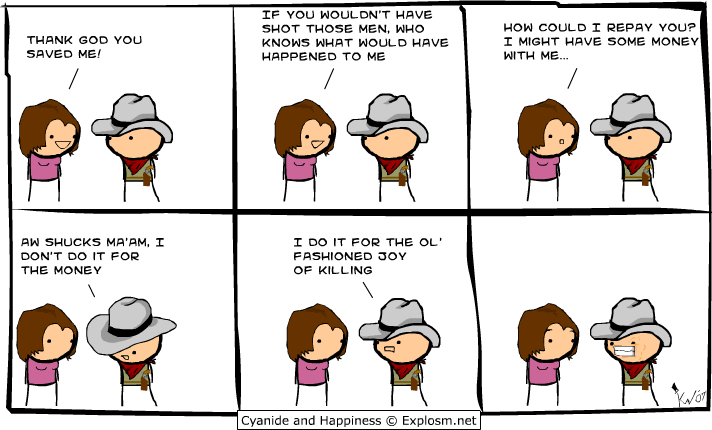I’m usually not one for TV. Though I rarely find myself watching TV shows, one of the two or three exceptions to this pattern in recent year has been Game of Thrones. It’s a show replete with instances of violence, many of which are rather interesting on top of being entertaining. There are two such instances I have in mind which struck me as particularly memorable: The first scene involves a fight been Jaime Lannister and Eddard Stark. The two fight each other while Jaime’s men stand back and observe. The fight is cut short, however, when one of Jaime’s men suddenly stabs a spear through Eddard’s leg, crippling him. Following that, Jaime approaches his ally who had disabled his opponent and knocks the man out for the assistance before riding off, leaving Eddard alive. While the scene is intuitively understandable to most viewers, if this were any other species being observed, we might find the behaviors all rather peculiar. Why did Jaime’s allies not step in to assist him sooner? Why did Jaime aggress against his own ally for helping him win a potentially-lethal fight? Why did Jaime not kill his opponent when he had the chance?
And, more importantly, why doesn’t my hair look that good?
The second scene I had in mind involves the fight between Bronn and Ser Vardis Egan. The two are engaged in a trial by combat, where the outcome of the fight will, as the name suggests, determine the guilt (and life) of Jaime’s brother, Tyrion, as well as the life of one of the fighters. Bronn, in this case, happens to be fighting on behalf of Tyrion. Bronn manages to win the fight by tiring his armor-clad opponent out, before crippling and killing him. Despite Vardis being surrounded by his allies, none of them join in the fight to help save his life. After Bronn wins, he is rebuked for his victory by the Queen of the Vale, who suggests that Bronn “doesn’t fight with honor”. Bronn responds with one of my favorite lines from the series: “No”, which he follows up by gesturing down the pit where his recently-defeated opponent was dropped, and continues, “He did”. Honor, it seems, can get a man killed, so why do people fight with or make a big deal about it?
While there are many other such instances of violence in Game of Thrones we might document, I wanted to use these as a vehicle to discuss a recent paper by Romero, Pham, & Goetz (2014) which examined people’s implicit rules of combat, specifically the acceptability of violent tactics. In their paper, the authors posit that a recurrent history of violence over human evolution – in conjunction with the potential costs associated with violence – likely had a hand in shaping human psychological mechanisms for learning about and responding to violence. In this case, prepared learning would be the order of the day. That is to say that violent conflict, owing to its risky nature, is often not the type of thing that lends itself neatly to repeated trial and error learning, so it is probable that human psychology comes equipped with cognitive mechanisms for structuring our understanding of violent conflict with very little or, in some cases, the absence of, explicit learning about or experience with such topics. This is similar to how monkeys can learn quickly to fear snakes but not flowers.
As people would want to avoid needlessly escalating play fights into lethal combat or fail to respond appropriately to others with lethal intent, we should expect (a) that the mind is structured to both classify violent acts into relatively distinct groups, and (b) that each group should have types of violence which are deemed acceptable or unacceptable in association with each context. The regulations on what kind of violence is associated with acceptability in each group should also correlate with the functions of violence in those contexts. Though the authors note that such a list is unlikely to be exhaustive, they highlight four groups into which violent conflict might classified: (1) play fighting, the purpose of which might be to prepare one for actual fighting later, but not to cause lasting injury, (2) status contests, the purpose of which is to establish dominance, but not to kill one’s rival, (3) warfare, the purpose of which is to settle between-group rivalries which may occasionally require lethal force, and (4) anti-exploitative violence, covering what people typically consider self-defense which, again, might occasionally require lethal force.
Not included in the list: Senseless and Leisurely violence
In the first study, 237 US students read about a scenario designed to capture each of these four contexts, and were then asked to rate the acceptability of 22 violent acts in each context. The violent acts ranged from minor (slapping and punching the body) to rather severe (eye gouging and the use of a deadly weapon), as confirmed by independent ratings. The authors predicted that more severe violent acts would increase in acceptability from play fighting, to status contexts, to warfare, to anti-exploitation contexts, owing to the function of violence in each context shaping the expectations of behavior in them. This was indeed the pattern that was uncovered: as violent tactics got more severe, endorsements of them as acceptable tended to decrease. The number of acceptable tactics was also lowest for play fighting, followed by status contests, warfare, and anti-exploitation tactics. Interestingly, experience learning about and discussing combat behavior did not have a significant effect on people’s judgments of an act’s acceptability. In the non-US sample of 91 Mturkers, that last result concerning learning was significant but, controlling for the level of experience, the above pattern generally replicated (though the mean values of acceptability were slightly different, with the non-US sample rating violence as generally more acceptable).
The second study really caught my attention, however, and it gets back to our initial Game of Thrones scenes. This study examined status contests specifically. The function of these status contests, as previous mentioned, is to establish dominance. They can also serve a signaling function by allowing others the chance to assess who is the better fighter within the boundaries of these implicit rules of combat. Individuals who break these implicit rules, then, end up obscuring the assessment of their relative fighting ability by granting themselves competitive advantages. To use a simple, yet extreme example, if you’re attempting to assess fighting ability in a boxing match and one boxer shows up to the fight with a knife, you learn less about each person’s relative boxing ability. Other types of “cheap shots” (i.e. violent tactics that extend beyond the normally accepted range for the type of conflict) similarly hinder honest information from being gathered from the results of the contest. This could be why it seemed so comprehensible to viewers for Bronn to be accused of lacking honor (as he was wearing his opponent out rather than fighting him directly) or why Jaime didn’t continue to fight Eddard after the spear through the leg (as winning no longer proves anything about the combatant’s skill).
The second study asked 234 participants to read the status contest story from the first study, but now one of the fighters employed tactics rated as overly-severe during that contest, including: bringing allies into combat, striking the testicles of the other fighter, or using a weapon. Participants also read about three novel contexts, in which one fighter handicapped himself, either by fighting with only one hand, fighting when outnumbered, or fighting a particularly formidable opponent. When the fighter in question employed one of the more severe tactics during the fight, they were assigned less respect than those handicapping themselves. On a 10-point scale, bringing allies to fight was rated as a mean of 2.58 in respect, striking the testicles was a 2.68, and using a weapon was rated as 2.14. By contrast, fighting with one arm was rated a 7.23, fighting outnumbered was 6.41, and fighting a formidable opponent was a 5.88. On the whole, men also tended to give somewhat more respect to fighters handicapping themselves, relative to women, perhaps owing to men generally being the ones doing the fighting.
Seems like a fair assessment of fighting ability
Now, as the authors note, the rules governing the classification of violent acts should be expected to vary somewhat from culture to culture. For some cultures, status contests might take the form of wrestling; in others, like the Game of Thrones world, status contests might sometimes involve the use of lethal weaponry. Some blurring of these categories, then, is a likely outcome at times. When duels are held with lethal weaponry, for instance, they might serve dual functions of status contests and anti-exploitation tactics, making classifications difficult. Despite that occasional blurring, however, we should expect people to have different expectations of the acceptable rules of violence contingent on its function. When the function is only to display status, grievous bodily injury should be relatively unacceptable; when the function is play fighting, even mild injuries should be frowned upon.
To turn this finding towards some personal experience, these results shed some light on the frequent complaint of many gamers concerning “honor” in their games, whether certain tactics are “cheap”, and whether certain things in the game need to be “nerfed” (i.e. have their power reduced). These complaints likely arise from a combination of the two aforementioned issues: first, if one player is using some severely-unbalanced or powerful item, the ability of each player’s skill to determine the result of the match shrinks, relative to the portion determined by the item. In the event that such tactics are too good and easy to pull off, the ability to display skill can be removed entirely. This would make the game less fun for many. Second, people might be treating these games as if they belong in different categories. Some players who play just for fun might treat them as play fights while others treat them as status competitions; still others might even treat them as anti-exploitation contexts. This could result in the different groups having different ideals as to how others should behave in game, and without agreement on the implicit rules resentment between players can build. A similar logic thus likely underlies non-violent status competitions, play, and anti-exploitation tactics as well. It would be interesting to see this line of research expanded into other areas of human competition.
References: Romero, G., Pham, M., & Goetz, A. (2014). The implicit rules of combat. Human Nature, DOI: 10.1007/s12110-014-9214-3



